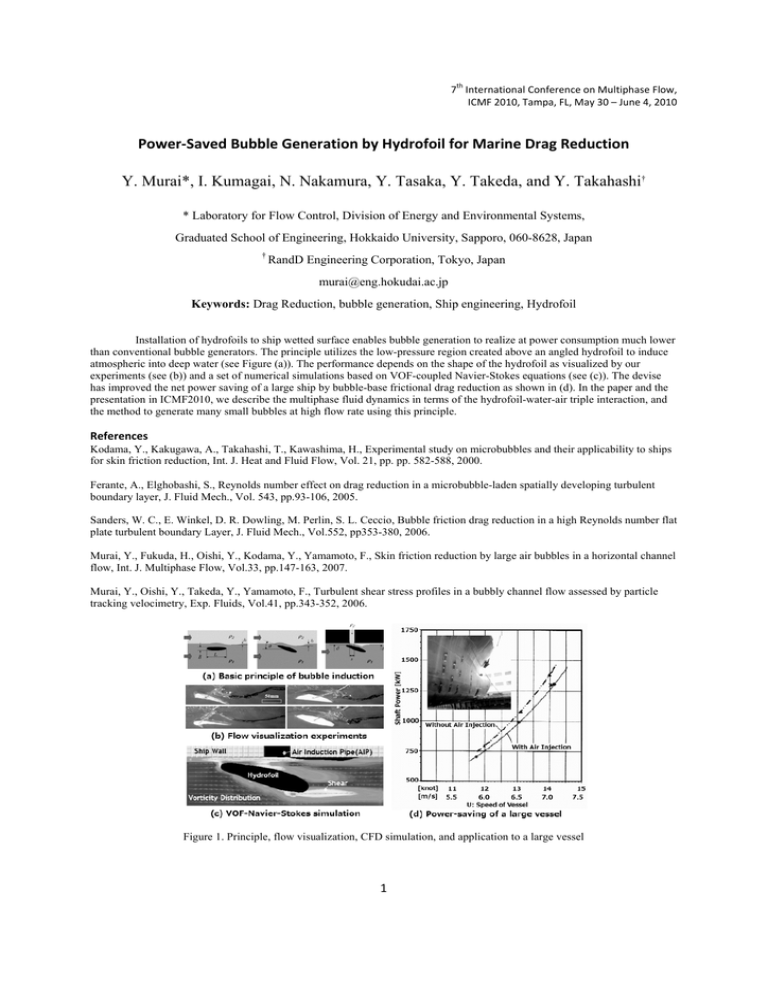Power-Saved Bubble Generation by Hydrofoil for Marine Drag
advertisement

th 7 International Conference on Multiphase Flow, ICMF 2010, Tampa, FL, May 30 – June 4, 2010 Power‐Saved Bubble Generation by Hydrofoil for Marine Drag Reduction Y. Murai*, I. Kumagai, N. Nakamura, Y. Tasaka, Y. Takeda, and Y. Takahashi† * Laboratory for Flow Control, Division of Energy and Environmental Systems, Graduated School of Engineering, Hokkaido University, Sapporo, 060-8628, Japan † RandD Engineering Corporation, Tokyo, Japan murai@eng.hokudai.ac.jp Keywords: Drag Reduction, bubble generation, Ship engineering, Hydrofoil Installation of hydrofoils to ship wetted surface enables bubble generation to realize at power consumption much lower than conventional bubble generators. The principle utilizes the low-pressure region created above an angled hydrofoil to induce atmospheric into deep water (see Figure (a)). The performance depends on the shape of the hydrofoil as visualized by our experiments (see (b)) and a set of numerical simulations based on VOF-coupled Navier-Stokes equations (see (c)). The devise has improved the net power saving of a large ship by bubble-base frictional drag reduction as shown in (d). In the paper and the presentation in ICMF2010, we describe the multiphase fluid dynamics in terms of the hydrofoil-water-air triple interaction, and the method to generate many small bubbles at high flow rate using this principle. References Kodama, Y., Kakugawa, A., Takahashi, T., Kawashima, H., Experimental study on microbubbles and their applicability to ships for skin friction reduction, Int. J. Heat and Fluid Flow, Vol. 21, pp. pp. 582-588, 2000. Ferante, A., Elghobashi, S., Reynolds number effect on drag reduction in a microbubble-laden spatially developing turbulent boundary layer, J. Fluid Mech., Vol. 543, pp.93-106, 2005. Sanders, W. C., E. Winkel, D. R. Dowling, M. Perlin, S. L. Ceccio, Bubble friction drag reduction in a high Reynolds number flat plate turbulent boundary Layer, J. Fluid Mech., Vol.552, pp353-380, 2006. Murai, Y., Fukuda, H., Oishi, Y., Kodama, Y., Yamamoto, F., Skin friction reduction by large air bubbles in a horizontal channel flow, Int. J. Multiphase Flow, Vol.33, pp.147-163, 2007. Murai, Y., Oishi, Y., Takeda, Y., Yamamoto, F., Turbulent shear stress profiles in a bubbly channel flow assessed by particle tracking velocimetry, Exp. Fluids, Vol.41, pp.343-352, 2006. Figure 1. Principle, flow visualization, CFD simulation, and application to a large vessel 1



